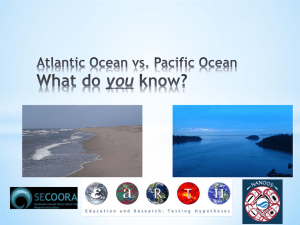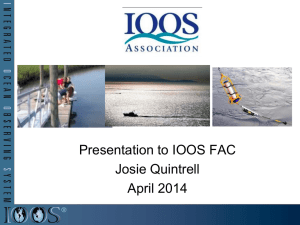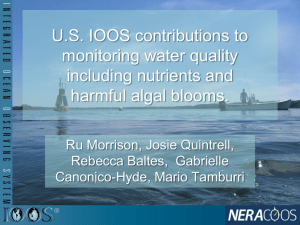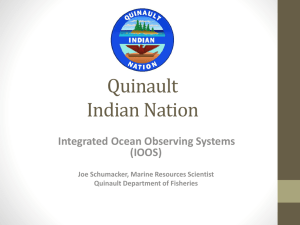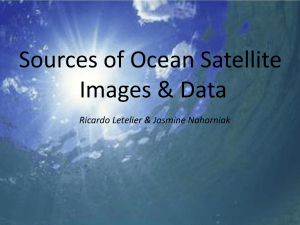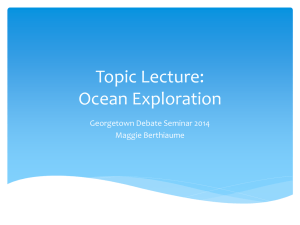ICOOS Reauthorization, Senate Hearing, Testimony from Jan Newton
advertisement
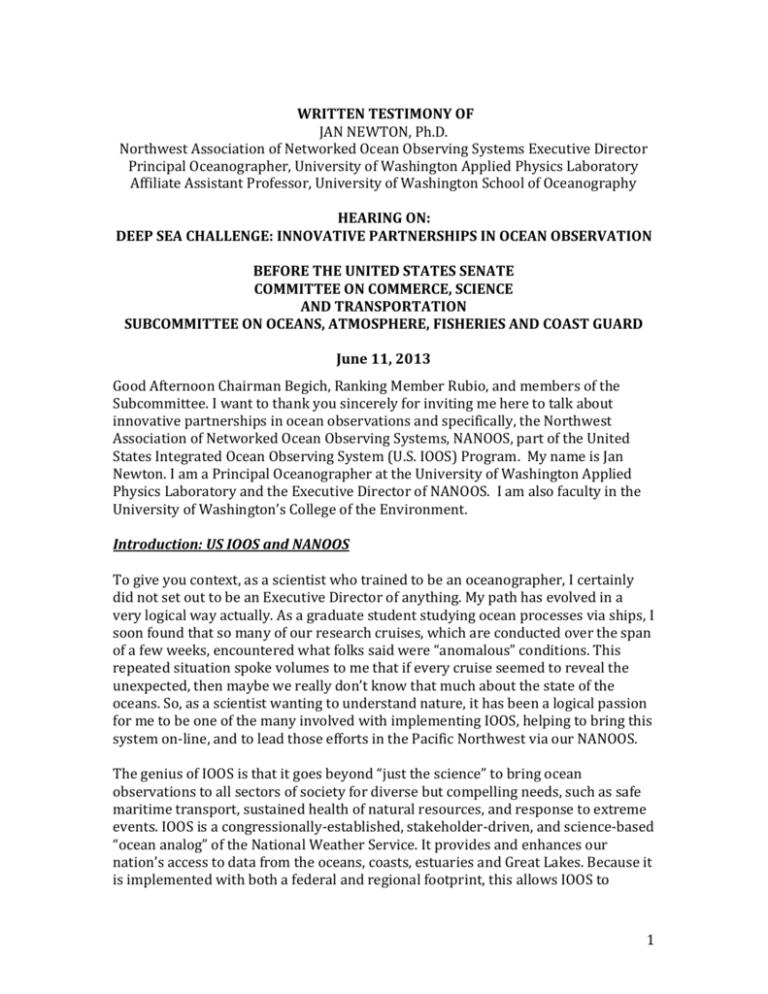
WRITTEN TESTIMONY OF JAN NEWTON, Ph.D. Northwest Association of Networked Ocean Observing Systems Executive Director Principal Oceanographer, University of Washington Applied Physics Laboratory Affiliate Assistant Professor, University of Washington School of Oceanography HEARING ON: DEEP SEA CHALLENGE: INNOVATIVE PARTNERSHIPS IN OCEAN OBSERVATION BEFORE THE UNITED STATES SENATE COMMITTEE ON COMMERCE, SCIENCE AND TRANSPORTATION SUBCOMMITTEE ON OCEANS, ATMOSPHERE, FISHERIES AND COAST GUARD June 11, 2013 Good Afternoon Chairman Begich, Ranking Member Rubio, and members of the Subcommittee. I want to thank you sincerely for inviting me here to talk about innovative partnerships in ocean observations and specifically, the Northwest Association of Networked Ocean Observing Systems, NANOOS, part of the United States Integrated Ocean Observing System (U.S. IOOS) Program. My name is Jan Newton. I am a Principal Oceanographer at the University of Washington Applied Physics Laboratory and the Executive Director of NANOOS. I am also faculty in the University of Washington’s College of the Environment. Introduction: US IOOS and NANOOS To give you context, as a scientist who trained to be an oceanographer, I certainly did not set out to be an Executive Director of anything. My path has evolved in a very logical way actually. As a graduate student studying ocean processes via ships, I soon found that so many of our research cruises, which are conducted over the span of a few weeks, encountered what folks said were “anomalous” conditions. This repeated situation spoke volumes to me that if every cruise seemed to reveal the unexpected, then maybe we really don’t know that much about the state of the oceans. So, as a scientist wanting to understand nature, it has been a logical passion for me to be one of the many involved with implementing IOOS, helping to bring this system on-line, and to lead those efforts in the Pacific Northwest via our NANOOS. The genius of IOOS is that it goes beyond “just the science” to bring ocean observations to all sectors of society for diverse but compelling needs, such as safe maritime transport, sustained health of natural resources, and response to extreme events. IOOS is a congressionally-established, stakeholder-driven, and science-based “ocean analog” of the National Weather Service. It provides and enhances our nation’s access to data from the oceans, coasts, estuaries and Great Lakes. Because it is implemented with both a federal and regional footprint, this allows IOOS to 1 connect with regional stakeholders while maintaining national consistency. IOOS is the essence of an innovative partnership. The US IOOS Program Office while housed at NOAA interacts with a broad federal agency family, as well as with a network of eleven non-federal Regional Associations. I want to tell you more about how we implement IOOS through one of those Regional Associations, NANOOS, in the Pacific Northwest. For the states of Washington and Oregon, we at NANOOS work with diverse stakeholders to understand their needs and to coordinate and support the development, implementation, and operation of a regional coastal ocean observing system– the buoys, radars, models and data management capacity – to provide ocean data and data products to diverse end users on the spatial and temporal scales that meet their needs. While I say “oceans” … in the context of IOOS and NANOOS this means the coastal ocean, which includes our estuaries, bays, and shorelines. How did NANOOS build its ocean observing system? We formed a partnership of Pacific Northwest industry, tribes, local, state, and federal agencies, non-government organizations, and educational and research institutions. Established in 2003, NANOOS is a growing partnership of almost 50 entities now. The NANOOS system encompasses not only ocean observations, but also data management, modeling and analysis, generating useful information products, providing outreach to various audiences to connect them with the information they need, and increasing the region’s ocean literacy. To do this, we had two very simple yet compelling strategies for building the system: 1) integrate the assets we had in the region and 2) prioritize what we needed. With NOAA funds, NANOOS implements IOOS regionally through its partnerships. How does NANOOS decide where to make our investments? The nearly 50 NANOOS member partners who have signed our Memorandum of Agreement (MOA) appoint a person to our Governing Council and annually establish NANOOS’ regional priorities. Using the input from our Governing Council, we have harnessed our infrastructure, the technological observing capacity as well as the skilled workforce, to build a networked system whereby at this very moment from our NANOOS data portal I can click on buttons that tell me the sea temperature 13 miles off La Push Washington, the pH in the seawater intake at Taylor Shellfish hatchery, the oxygen at the bottom of Hood Canal, the sediment load in the Columbia River, the offshore currents along the coast of Oregon, and the predicted temperature of the coastal waters off Newport. These may sound like disparate and esoteric things to know, but to the shellfish growers who wants to know whether to spawn their oyster larvae, to the fisheries manager who wants to know if fish are subject to stress from reduced oxygen before setting fisheries catch limits, to the Columbia River bar pilot who wants to navigate the entrance channel safely, to the true heroes of the Coast Guard who need to optimize the effectiveness of their 2 search and rescue operations, and to the recreational tuna fishing captains who want to optimize their safety and profitable local businesses, these data all inform decision points that NANOOS currently delivers to these users. Each one of those examples I mentioned is a real case showing how NANOOS is making a difference through our partnerships. What does NANOOS achieve for the nation and the region? By building NANOOS, we have dramatically increased the efficiency in how tax-payer purchased ocean data as well as privately-funded ocean data reaches the hands of the public, both regionally and nationally. My two favorite words to describe IOOS and NANOOS are “leverage” and “link,” which we do in spades. The federal investment in NANOOS reaps substantial return, for example, we use our federal dollars received from the US IOOS Program Office to partially, yes partially, support 19 data streams throughout Washington and Oregon. Yet because of the partnerships we have made, our data portal makes 176 data streams available to the public…nearly an order of magnitude more. The balance are federal assets (funded by other federal programs) collected throughout our region as well as private, state, tribal, or other data providers who want the data services that NANOOS offers. As we collect and integrate these disparate data streams, we are able to use them to provide information products like the types I mentioned above. There is a second efficiency in IOOS, and that is that we have built a community of practice. We have integrated the people. This is another aspect of innovative partnership that has paid off substantially. Our data management system was designed and implemented by a team from three regional universities, UW, OSU, and OHSU, working the Boeing Company, an industry with a wide footprint in our region. Each member organization came with a unique perspective and capability, but together as a team they built a system that has seen great success and has been shared with other IOOS Regional Associations. The innovation that happens at the regional level is shared with the national level and vice versa; regional data systems are linked through standards and protocols to the national system. Our observational effort on water quality has integrated university, federal, tribal, state, and industry scientists and practitioners, to share practices and increase data quality. Also, when a new and better sensor comes along, NANOOS can take advantage of letting this network know about it, and if adequately funded, NANOOS could provide the new sensors to our partners to implement on their existing platforms. NANOOS and the IOOS Regional Associations in California have a Memorandum of Understanding with the West Coast Governors Alliance to work collectively together and optimize efforts on marine spatial planning, ocean acidification, marine debris, and other priorities. The NANOOS observing system sustains high-frequency radars that measure surface currents off Oregon; NANOOS serves these data directly to the U.S. 3 Coast Guard to assist with search and rescue. Our new NANOOS “Maritime Operations” portal, developed with input from mariners, like the Marine Exchange of Puget Sound, provides real-time wave observations offshore the coast, high-resolution wave forecasts out to 84 hours in the future, virtual wave stations showing changes in wave height and where the waves are coming from, and high-frequency radar surface maps of ocean currents. This is part of the national HF Radar network, a direct result of US IOOS. In 2002 there were only a handful of radars; this has now grown to 130, all operated as a single network with nationally compatible data. Operation by 30 academic institutions nationwide in partnership with a US company (CODAR Ocean Sensors), all led by the US IOOS program is the kind of innovative partnering that epitomizes US IOOS. NANOOS Successes from Innovative Partnering The federal investment in sustaining ocean observations makes a difference and provides a significant return on investment. For example, prior to 2010 there were no sustained observations of subsurface water properties, like oxygen, nutrients, pH and chlorophyll off the coast of Washington. We were able to obtain a $500K grant from the Murdock Charitable Trust to build a state-of-the-art observation system, with surface and profiling buoys and an autonomous Seaglider, to yield 3-dimensional data through time. Our successful competition for this award was in part because IOOS represented anticipated funds for sustaining the operation of these assets well into the future. Now three years in, we have an unprecedented data series, new scientific discoveries such as 40 m high internal waves, as well as key data to assess hypoxia and ocean acidification. It was obvious to the Murdock Charitable Trust that NANOOS was well-networked within our region and the payoff from the data would be shared, not only to regional scientists but also so many others across society. We have partnered with NOAA’s Olympic Coast National Marine Sanctuary to add a current meter they had onto our buoy, with the Quileute Tribe to optimize the buoy’s weather sensing, and with NOAA’s Ocean Acidification Program and NOAA’s Pacific Marine Environmental Laboratory to work together measuring variables to assess ocean acidification on this buoy, now part of the NOAA Ocean Acidification Buoy Network. The IOOS observing system, including this buoy, is being utilized to provide an early warning system for ocean acidification to support local shellfish growers and hatchery owners, helping them to save over $35M in 2011 alone. A local shellfish grower, Mark Weigardt, co-owner of Whiskey Creek Shellfish Hatchery said it this way: “Putting an IOOS buoy in the water is like putting headlights on a car. It lets us see changing water conditions in real time.” Some of our other successes: NANOOS assisted Oregon and Washington state agencies with the development of a Pacific Northwest tsunami evacuation portal and mobile app; a visual representation of the expected inundation of coastal areas and communities from a worst-case locally generated tsunami (similar 4 magnitude to the 2011 Japan earthquake), as well as from a distant event adjacent to the Aleutian Islands. Users search by street address to determine if they are in the tsunami hazard zone, and plan an escape route accordingly. The portal also provides direct links to the West Coast Alaska Tsunami warning center, notifying users of a tsunami watch or warning. NANOOS supports the collection of beach information –– flooding, erosion, and seasonal sand changes –– along the Oregon and Washington coasts. These data are being used by engineers and resource managers to assist with the design and permitting of coastal engineering structures, to understanding the rates and patterns of coastal change, and to support FEMA. Now Columbia River bar pilots, like Captain Dan Jordan, a NANOOS advisor, can access real-time wave conditions directly offshore of the Columbia River’s mouth—a busy port of entry with hazardous currents and large waves —to assist with the safe passage of vessels. The Pacific Northwest, home to more than 20 ports supporting commercial, fishing, transportation, security, and recreational activities, benefits from this information service. The ports connect the U.S. with foreign markets and with a fishing industry worth about $800 million in personal income annually. The Columbia River system handles 30 million tons of foreign trade and $16 billion in value each year. I think these examples show how IOOS and NANOOS are good government, implement national priorities on a regional scale, stimulate the economy, provide jobs, and increase quality of life for the nation. While there are many successes, we could do much more. For example, you will notice I said “NANOOS observing system sustains high-frequency radars that measure surface currents off Oregon.” NANOOS sustains these systems, originally purchased through research grants through the National Science Foundation. NANOOS has proposed to build similar capacity in Washington, but funding allocated to the IOOS program has not been sufficient to allow us to do so. Elsewhere such surface current data are used in combination with computer-run models to predict the movement of water, tracking associated items such as marine debris and harmful algal blooms. We do not have this capability in Washington state, and I know many of the other IOOS Regional Associations face similar inequities in their regions. Our nation deserves a contiguous capacity along all its coasts for measuring surface currents through this proven technology. The Future for IOOS and the ICOOS Act Re-authorization The IOOS Program stands on the shoulders of great visionaries, such as Admiral Watkins. US IOOS was recommended by both the Ocean Commission established by former President Bush, the Pew Commission which stills calls for its full implementation, and the importance of sustained observations is called out in President Obama’s National Ocean Policy. The Integrated Coastal and Ocean 5 Observing System (ICOOS) Act passed by you and signed into law by President Obama has been a strong tool to advance US IOOS. Administered by NOAA as the lead federal agency, the US IOOS Program has been well conceived and, I believe, very well implemented. The success stories I shared here are repeated many times over within NANOOS, but also within the other ten Regional Associations of IOOS, comprising the entirety of the United States, including its Great Lakes, Caribbean and Pacific Islands, and three continental coastlines, Atlantic, Gulf and Pacific. IOOS has stimulated green U.S. jobs and technology innovation. In short, IOOS works. The ICOOS Act of 2009 enables IOOS to be a federal-regional partnership that connects with regional stakeholders while maintaining national consistency and addressing national priorities at the regional level. I strongly urge you to reauthorize the ICOOS Act so that this successful example of governmental efficiency and innovative federal-non-federal partnership can continue and grow. The IOOS distributed system, as witnessed by the diverse membership of its 11 Regional Associations, by its NOAA leadership and the US IOOS Program Office, the Interagency Ocean Observing Systems Committee, and by the nearly 200 individuals who attended the IOOS Summit held in Reston VA in November 2012 and signed its Declaration from which I quote: “Now, more than ever, the United States requires a sustained and integrated ocean observing system.” I am grateful to our Washington State Senator Maria Cantwell for her leadership in supporting IOOS and promoting the re-authorization of the ICOOS Act. I want to underscore the importance of Congress’ funding of IOOS at levels that do not jeopardize the sustained operation and expansion of IOOS. I applaud the Senate for your leadership on this to date. Without your action in 2012 and 2013, I potentially faced having to cut the program by $250K. With a program so highly leveraged already, my decision for a cut of that magnitude was to either eliminate support for our data delivery system, or estuarine observations in Puget Sound and the Columbia River, or observations on the WA and OR outer coast, or observations of the shorelines. Given the input from our Governing Council I honestly did not know how to make that decision. I thank you for preventing me having to face that. Climate Change and the Oceans You have also requested my input on the implications of climate change on ocean waters, such as warming, altered productivity, and ocean acidification. As a teacher, it is my honor to comment on the importance of these ocean issues. First I ask that we all take a breath…and after you do that take another. Please understand that the oxygen for every other breath you take is supplied by algae, phytoplankton, in the worlds’ oceans, with the other breath from terrestrial plants, trees and grasses. With Earth’s land masses being productive, yet in the minority…only 33% of the surface of the earth…we absolutely depend on the oceans for our very life. I often reflect that sight of the sea surface without any land visible is a foreign sight to most of the population of our planet, yet it truly is the most common sight on planet Earth. 6 As humans have changed the composition of our atmosphere, these alterations have indeed heated the planet and increased the concentration of CO2 that diffuses into the oceans. These changes have very strong implications for the plankton at the base of the ocean food web and all that depend on these organisms. As the heating changes the temperature of seawater and its density layering, this inhibits the ability of the ocean to supply nutrients upward and to ventilate its deep waters with oxygen; these changes have implications to select for an ocean that does not support the same life in exactly the same way we are accustomed to. While there will undoubtedly be as yet unpredicted consequences there are some things we do know that are well established scientifically. As the increased CO2 changes the pH of the ocean waters towards a more acidified state, this selects for what life forms can thrive. Species such as oysters, pteropods (food for salmon) and of course ecosystems such as coral reefs have less capacity to be formed or be competitive. Ocean Acidification It has been my professional honor to work with Dr. Richard Feely of NOAA’s Pacific Marine Environmental Laboratory and his group researching ocean acidification in the local waters of Washington State. It has also been my responsibility to direct the capacity of NANOOS to participate in making high quality measurements for assessing, modeling, and communicating the status of ocean acidification in the Pacific Northwest. NANOOS works via IOOS with the NOAA Ocean Acidification Program (OAP), whose mandate is to provide the nation with high quality data and leadership on this issue. Two of NANOOS’ offshore buoys, one off Newport and one off La Push, receive OAP funding to be part of our nation’s Ocean Acidification Buoy Network. The synergies between these federal programs and NANOOS have assured the most effective use of limited ocean observing resources and also provide free data access to our regional citizenry via the NANOOS data portal. While local data access is important, another true wisdom of IOOS is its nested design, such that any data stream NANOOS serves, such as Taylor Shellfish pH data from Puget Sound, immediately is available through the national IOOS data portal and available to the global community as well. The issue of ocean acidification is not only central to the vitality of our thriving shellfish industry, but also to the tribes who have treaty rights to sustained natural resources that have fed their culture for thousands of years. Additionally, seafood such as oysters and salmon are healthful foods that support our populace not only regionally but also, via export, nationally and internationally. I was one of seven scientists appointed to Governor Christine Gregoire’s Blue Ribbon Panel on Ocean Acidification. Our panel consolidated and reported what was known in our region regarding ocean acidification, what information was missing, and what recommendations and actions were needed to insure the health and economy of Washington State. It appears that some of these recommendations will be funded through the Washington State legislature, actions such as monitoring, forecasting, and food-web impact assessment. These actions dovetail extremely well 7 with the federal investments from NOAA’s OAP and from US IOOS in NANOOS. National leadership that can be implemented regionally can only succeed when there is a strong community of practice that builds an allegiance and the human network required to assure that common methods and calibrations are implemented. The NOAA OAP has been adept at partnering with IOOS Regional Associations throughout our nation to expand their network several-fold in a highly cost effective manner, yet with consistent methodology. NOAA’s leadership on this is to be commended. The re-authorization of the Federal Ocean Acidification Research and Monitoring (FOARAM) Act will assure this will continue and I urge your action to make this so. Summary I hope my testimony has illustrated the critical importance of the oceans to so many of our daily practices, from breathing to shipping cargo, and the great successes IOOS has already realized in serving to bring ocean information to the public. I hope you share my view that this system has an even greater potential to build on the innovative partnerships we have established, if adequately funded, but that the reauthorization of the ICOOS Act is essential. I hope I have underscored in your minds the importance of the oceans’ health. The 30% increase in ocean acidity we have achieved to date is not the direction our children will appreciate from us. The reauthorization of the FOARAM Act is imperative to guide the legacy we will want to leave. I thank you for your leadership to our country and for this opportunity to convey how urgent I think these two Acts are for our nation. 8
